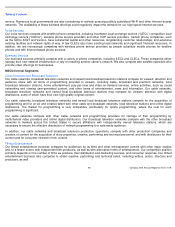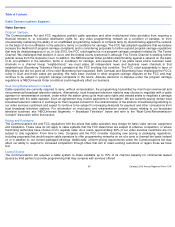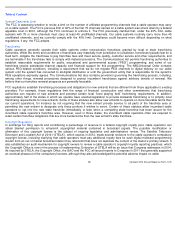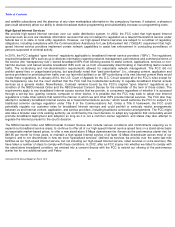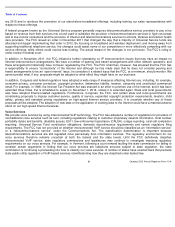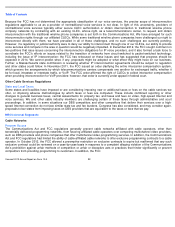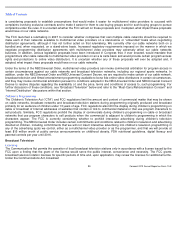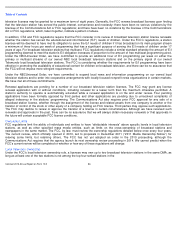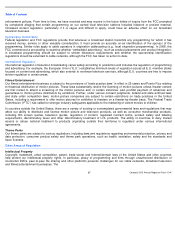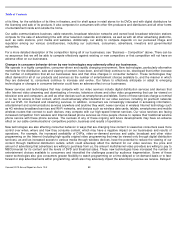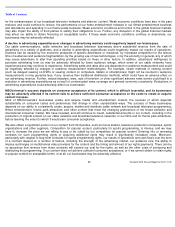Comcast 2013 Annual Report Download - page 30
Download and view the complete annual report
Please find page 30 of the 2013 Comcast annual report below. You can navigate through the pages in the report by either clicking on the pages listed below, or by using the keyword search tool below to find specific information within the annual report.
Table of Contents
market based on audience share as of the date an application for approval of an acquisition is filed with the FCC and at least eight
independently owned and operating full-
power broadcast television stations remain in the market following the acquisition. Further,
without regard to the number of remaining independently owned television stations, the rule permits the ownership of more than
one television station within the same DMA so long as certain signal contours of the stations involved do not overlap. The 2011
Media Ownership Notice proposes minor modifications to the local television ownership rule. It also raises questions regarding
whether local news
-
sharing agreements, shared services agreements, and joint sales agreements that involve the right to jointly
negotiate retransmission consent should count toward the FCC’
s ownership limitations. The stations owned by the NBC network or
the Telemundo network, however, do not have agreements that involve the right to jointly negotiate retransmission consent.
National Television Ownership
The Communications Act and FCC regulations limit the number of television stations one entity may own or control nationally.
Under the rule, no entity may have an attributable interest in broadcast television stations that reach, in the aggregate, more than
39% of all U.S. television households. Our owned local television station reach does not exceed this limit. In September 2013, the
FCC launched a rulemaking that considers eliminating a rule that currently affords UHF stations (channels 14 and above) a 50%
discount in calculating the extent of an individual station owner’
s holdings under the national cap. Adoption of this proposed change
would place us closer to the national cap and limit our flexibility to acquire stations in the future.
Foreign Ownership
The Communications Act generally limits foreign ownership in a broadcast station to 20% direct ownership and 25% indirect
ownership (i.e., through one or more subsidiaries), although the limit on indirect ownership can be waived if the FCC finds it to be in
the public interest. These limits have been held to apply to both voting control and equity, as well as to ownership by any form of
entity, including corporations, partnerships and limited liability companies. For many decades the FCC has declined to waive the
25% indirect limit in broadcast transactions, but in a November 2013 declaratory ruling, the FCC stated that it is now willing to
consider such waiver requests.
Dual Network Rule
The dual network rule prohibits any of the four major broadcast television networks, ABC, CBS, Fox and NBC, from being under
common ownership or control with another of the four.
Must-Carry/Retransmission Consent
Every three years, each commercial television station must elect for each cable system in its DMA either must-
carry or
retransmission consent. Federal law and FCC regulations also establish a must-
carry/retransmission consent election system for
carriage of commercial television stations by satellite providers. For the period beginning on January 1, 2012 and ending on
December 31, 2014, all of our NBC network and Telemundo network owned local television stations, except for certain Telemundo
local television stations acquired in 2013, elected retransmission consent.
In enacting STELA in 2010, Congress modified certain aspects of the compulsory copyright licenses under which satellite providers
and cable operators retransmit broadcast stations. STELA expressly extended to January 1, 2015 an existing prohibition against
commercial television stations entering into exclusive retransmission consent agreements with multichannel video providers and
also extended a requirement that commercial television stations and multichannel video providers negotiate retransmission consent
agreements in good faith. Several other multichannel video providers and third parties filed a petition asking the FCC to initiate a
rulemaking to consider changes to the current retransmission consent regulations and also asked Congress to review the issue.
The FCC launched a rulemaking in 2011 that, among other things, seeks comment on proposals to modify the good faith
negotiating standard and to eliminate regulations providing
25
Comcast 2013 Annual Report on Form 10
-
K


